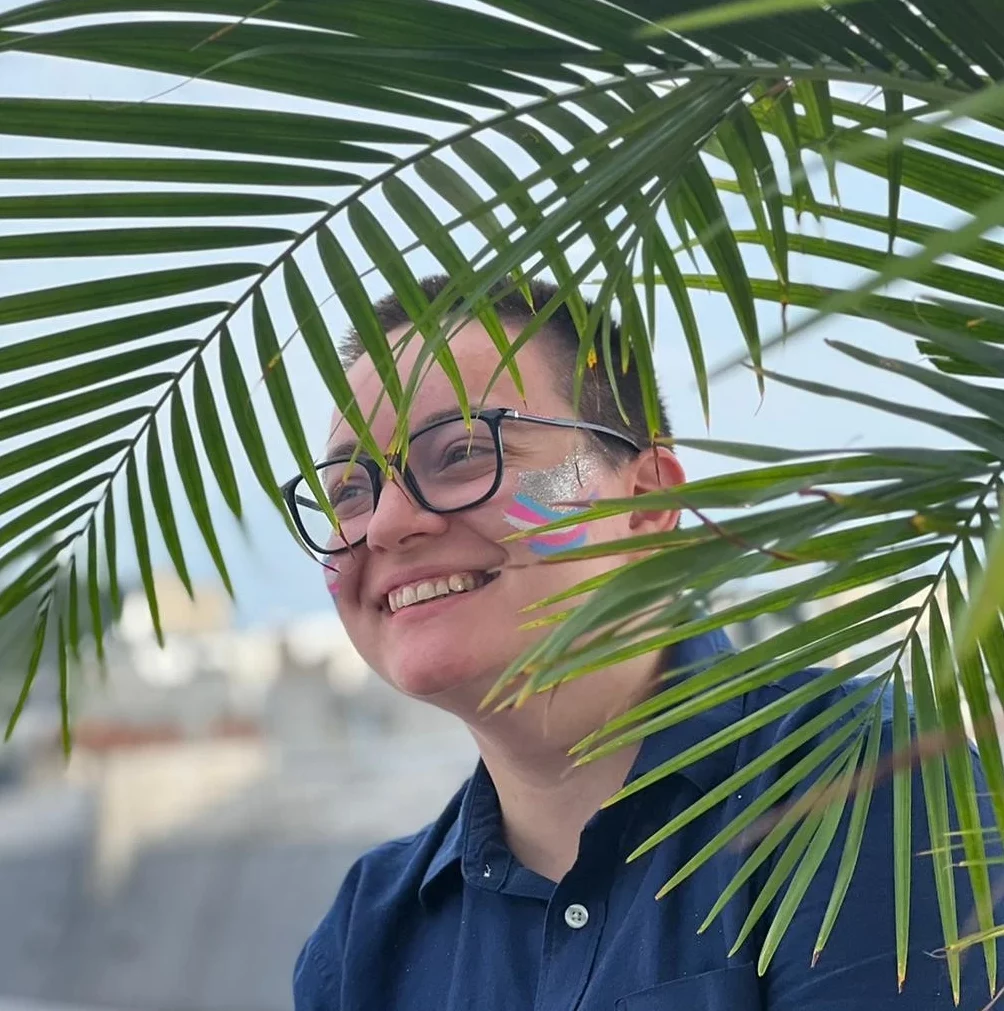Going to Zagreb
The train from Bled to Zagreb, by way of Ljubljana, is extremely slow. It’s also incredibly beautiful (you might be sick of me calling everything beautiful, but it’s not my fault, everything really is!!). The railway follows a perfectly turquoise river for a solid hour.
At one point, the last stop before the border according to OpenStreetMap, the train stops. Five, ten, twenty, thirty minutes. Not a single announcement, nobody comes to see us. I am mildly terrified. Eventually, it starts again.
We arrive in Zagreb twenty minutes late, which checks out given that stop. It’s night time, but even without any natural light, I can see that there are very imposing and cool buildings in front of me when I get out of the train.
I walk 25 minutes to go to the hotel. It’s on the main street of the city, which is cool, and at 9pm the city is lively as ever. I am, however, very confused vy the hotel for a minute: the ground floor doubles as a bar and there’s a blind test night which is very, very loud. I have to walk across the crowded bar with my backpack to the reception, where I’m handed a key card.
The room is very original and pretty cool, decorated with New York Times covers and articles from before the newspaper decided to be obsessed with people’s genitals. I’d really appreciate that, fi it wasn’t for the mold-smelling bathroom and for the full-volume blind test going on just under my bed. Even with my earbuds on and a pillow pressed against my ear, I can identify most of the songs – too bad it’s a team event. The only thing going for me is that I’m so exhausted, I still fall asleep pretty fast.
Stats
- Steps: 18 575
- Bus: ~30mins, 8.3km
- Train: 2h56, total 1158km
Day 1
I slept decently well, considering the circumstances, and woke up after 9am for the very first time of the trip (in fact, I woke up after 8am for the first time of the trip too). I don’t feel great, but it will have to do.
The first thing I do is alk around idly, which takes me in less than five minutes to a funicular I’ve heard of: it’s the shortest funicular in Europe and it’s very cute! A ride costs 66cts (given the number of things that cost 66 cents here, I’d wager that’s what the old currency was worth in the newly-adopted euros) and lasts less than a minute. I feel very proud as I tell myself that I’ve preserved the knee.
From the Upper Town of Zagreb, and especially from the old town that’s above the rest, you have a pretty nice view of the city. I don’t stop at the more classic view, I keep walking until I find a more village-side view that I’m satisfied with.

St Mark’s Church is extremely in your face and I love it!
But first, a disclaimer: I’m writing this after the time spent in Zagreb, which means that I’ve already done the city tour that Narrator Alex has not yet thought of. Because during that tour, we revisited some of the places from the morning, I’ll be merging the information from the tour with my experience from the first exploration.
Saint Mark’s Church is, as I said, very « in your face ». More specifically: it has a tiled coloured roof including the emblems of Zagreb and of Croatia (I suppose?) and a few different colours: yellow, black, and the Croatian red white and blue (not to be confused with half of the world’s other red white and blues, or France’s blue white and red). The yellow and black actually stands for the Austro-Hungarian Empire, which owned Zagreb at the time of the roof renovations. But it’s really barely there: the church is actually a symbol of Croatian identity because it refuses to be all yellow and black and gives a much bigger place to the national colours.
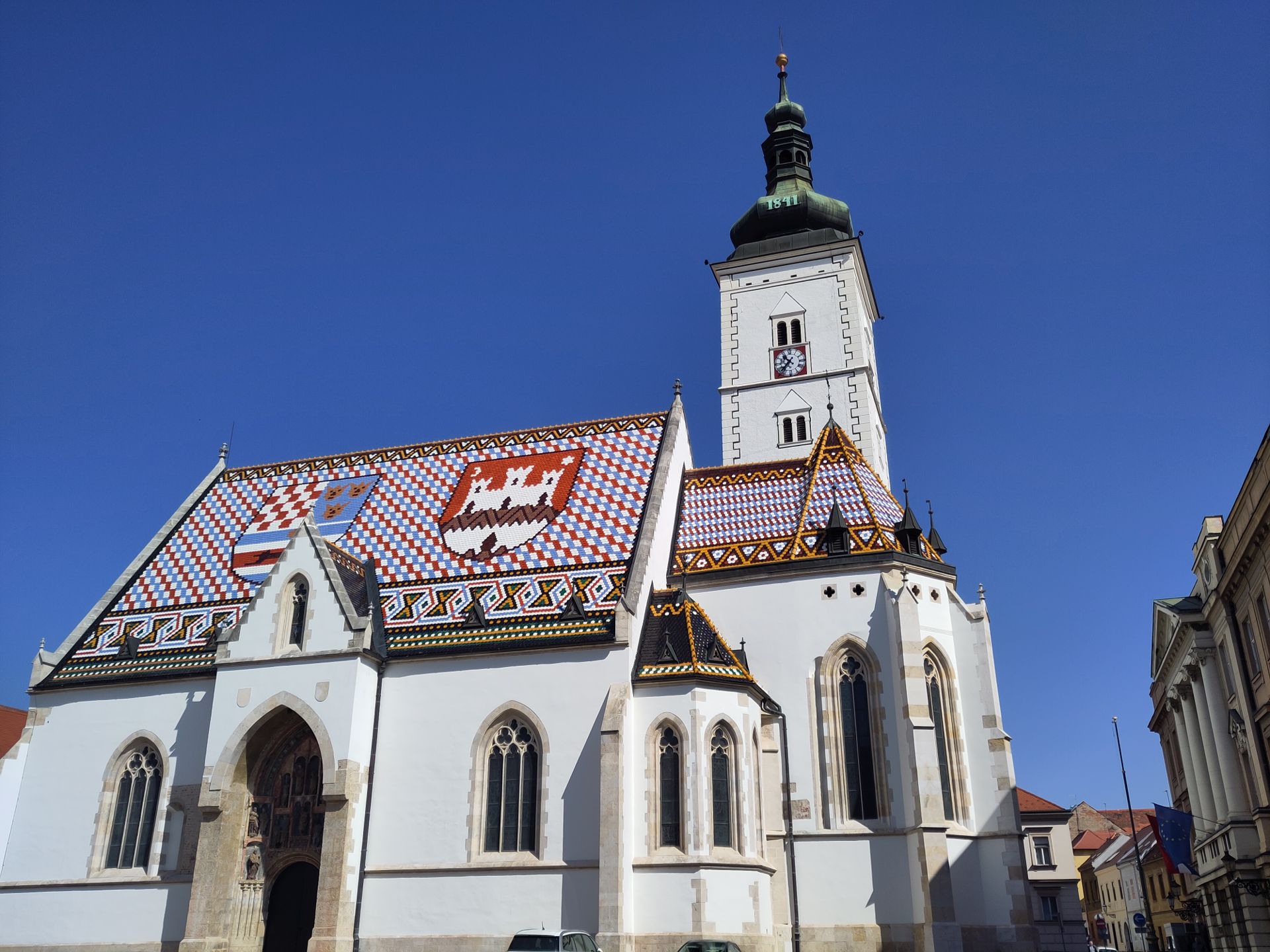
The church sits on a beautiful plaza which also houses the parliament, also beautiful. But right now, it’s cordoned off. The fences were installed in Septembre 2020 by order of the Prime Minister with no reason given to the public, which makes it look like a power play more than anything else. People used to be able to walk around, and now they can’t anymore, and it sucks.
One thing that strikes me as I walk around with no context whatsoever is that everything seems to be under construction, as much if not even more than in Venice – and I can’t figure out how to go to the city museum. As I’ll later discover, that’s because there were big earthquakes in 2020 and reconstruction has been taking forever. To be fair, it can’t be easy: most of the older buildings in the city were damaged and now they need to be completely renovated, including securing the foundations, while keeping the original look intact for historic heritage reasons. But that’s the reason why many, if not most, of the city’s museums are closed and why it sometimes seems that every single monument is either decrepit or hidden by scaffolding.
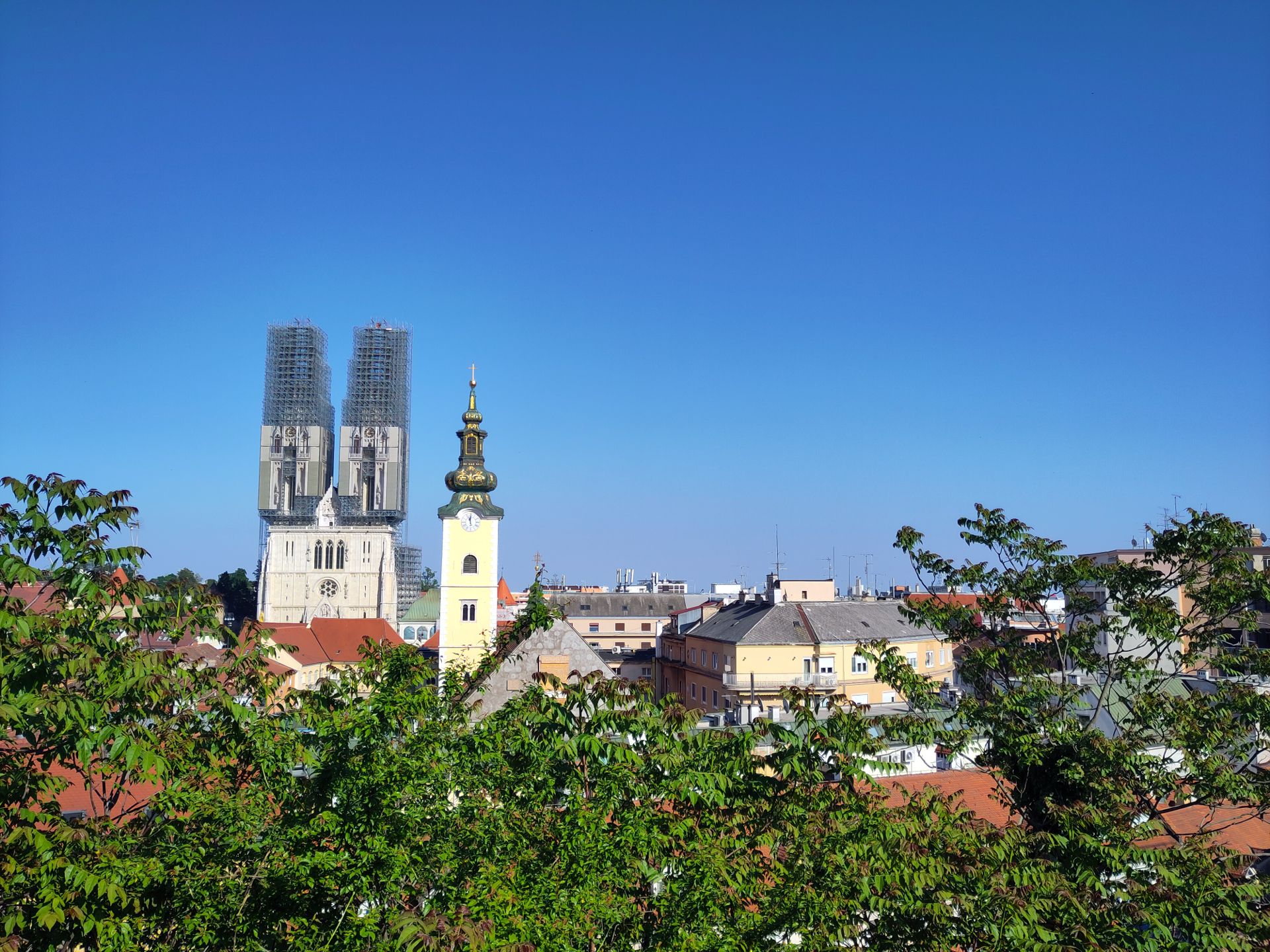
I keep on walking, and find a road that circles the outside of the old town. It’s quiet and pretty, and very sunny of course – I’m starting to consider this to be standard weather and will be sorely disappointed when things go back to normal April weather, if they ever do.
Since I was denied the City Museum and History Museum experience, I walk into the first open museum I see: a museum of the 1980s, where an apartment from the 1980s has been reconstructed, with era-appropriate brands and furniture, and some bonuses like a typical (and tiny) car of the times. The museum prides itself on letting you touch and use anything you want, which I think is a pretty fun idea, until I try:
- using a turnstile
- using a computer that only runs BASIC
- playing Pac-Man
At this point, I decide the 1980s are not for me, because that’s the only alternative to admitting that I suck at everything, of course.

My knee is feeling fine, but the rest of my body would really like to sleep now. It’s just before lunch, so I decide to break down my afternoon. First, I’ll eat; then, I’ll have a nap at the hotel; finally, I’ll do a cycling guided tour of the city at 4pm.
I eat okay-ish ćevapčići (not nearly as good as the ones I had at Sarajevo 84 in Ljubljana), curse at the travel guide that told me to go to that place, and go to sleep.
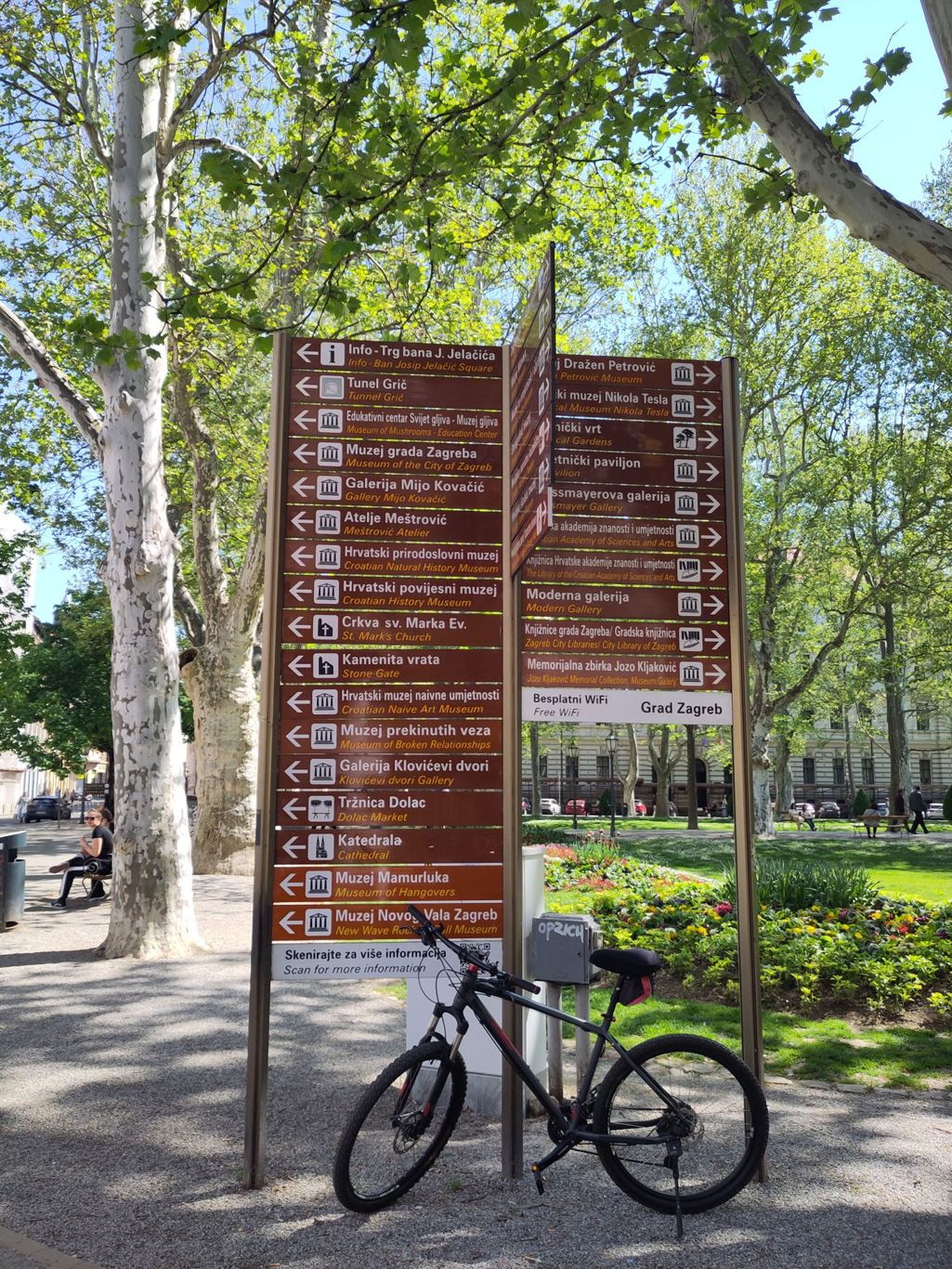
(This bike is not mine. I think it’s funny that Zagreb has so many museums.)
The bike tour
I book a Blue Bikes tour of the city’s highlights, which is scheduled to last 2.5 hours.
Our guide, Alida, is an absolutely wonderful and adorable person, as well as being very knowledgeable. I love that she’s got personal stories and not just historical accounts, and that she takes the time to answer any question, no matter how basic.
In this tour, I learn that the cathedral (which I photographed earlier in this post, but it’s in construction because a tower fell during the earthquake) was built in the 11th century and then protected by fortified walls so that the Turks wouldn’t take it… except the Turks never even came to Zagreb.
(Speaking of protecting the city from invaders, yes, I did find a Napoleon memorial statue.)
We then keep going around, seeing some of my views from the morning and some new ones, until we get to the statue of Nikola Tesla.
Sorry about this Elon guy, mister Tesla.
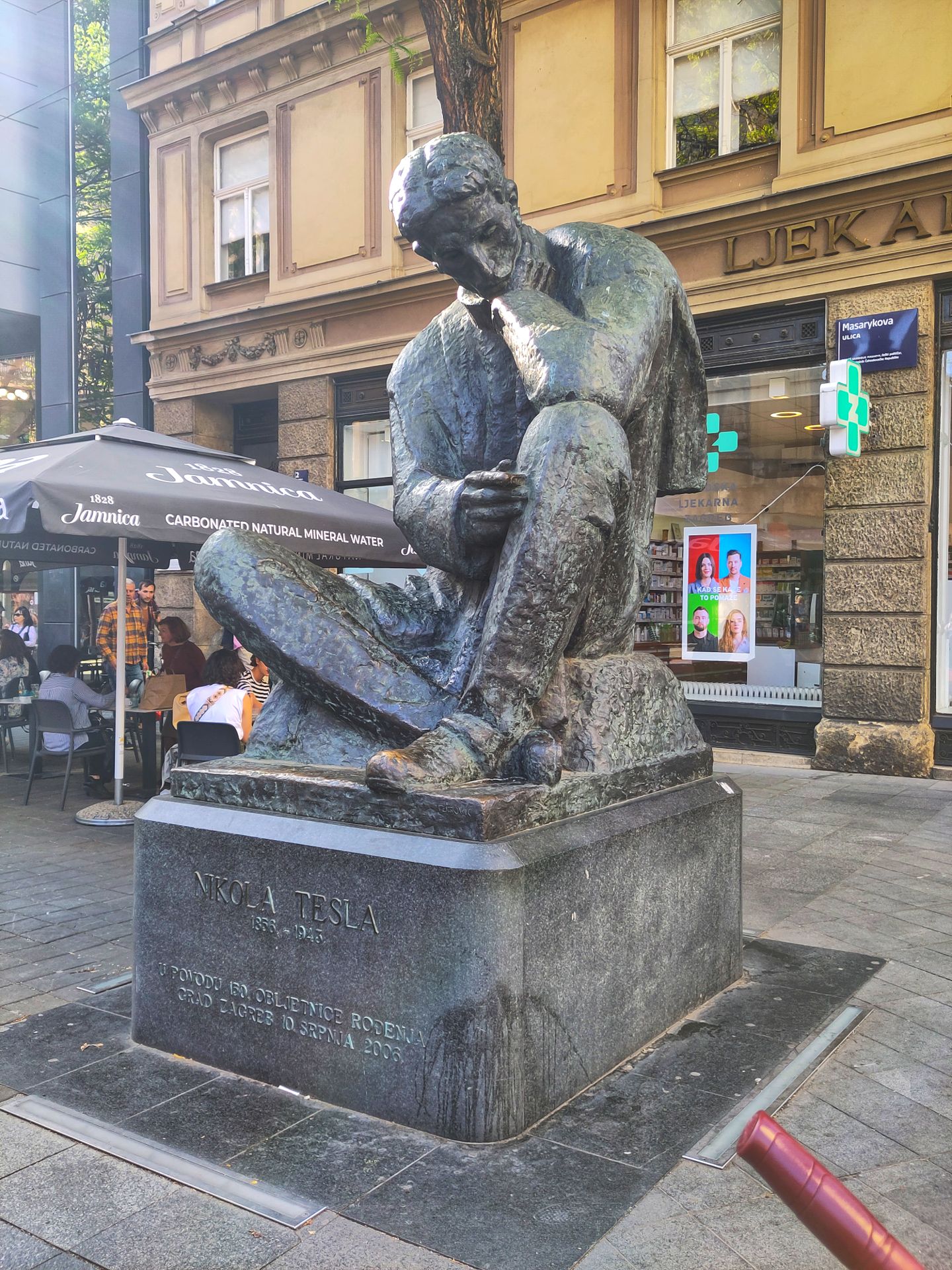
Alida gives us some background on lil’ Nicky here: he was born in Croatia, in a Serbian family, and then emigrated to the United States. When asked whether he felt more Croatian or Serbian, he always refused to take a side. So, naturally, both sides dunked on him pretty heavily.
In the 2000s, Tesla gained a lot of popularity in the United States, so Croatians and Serbians immediately started claiming him for themselves, of course, after a century of both sides shunning him. Alida finishes with a smirk: « We’re winning the contest for now, because we joined the Euro zone and we put his face on our coins, and Serbia can’t do that! »
Right in front of the statue, vivid street art celebrates the street recently becoming a car-free zone. Gotta love cities that are pushing back on cars!
(I do have to admit, I was scared senseless several times while cycling, as people here are supposed to cycle on the sidewalk and not on the street. You have to constantly be on the lookout for the people on foot, it’s exhausting!)
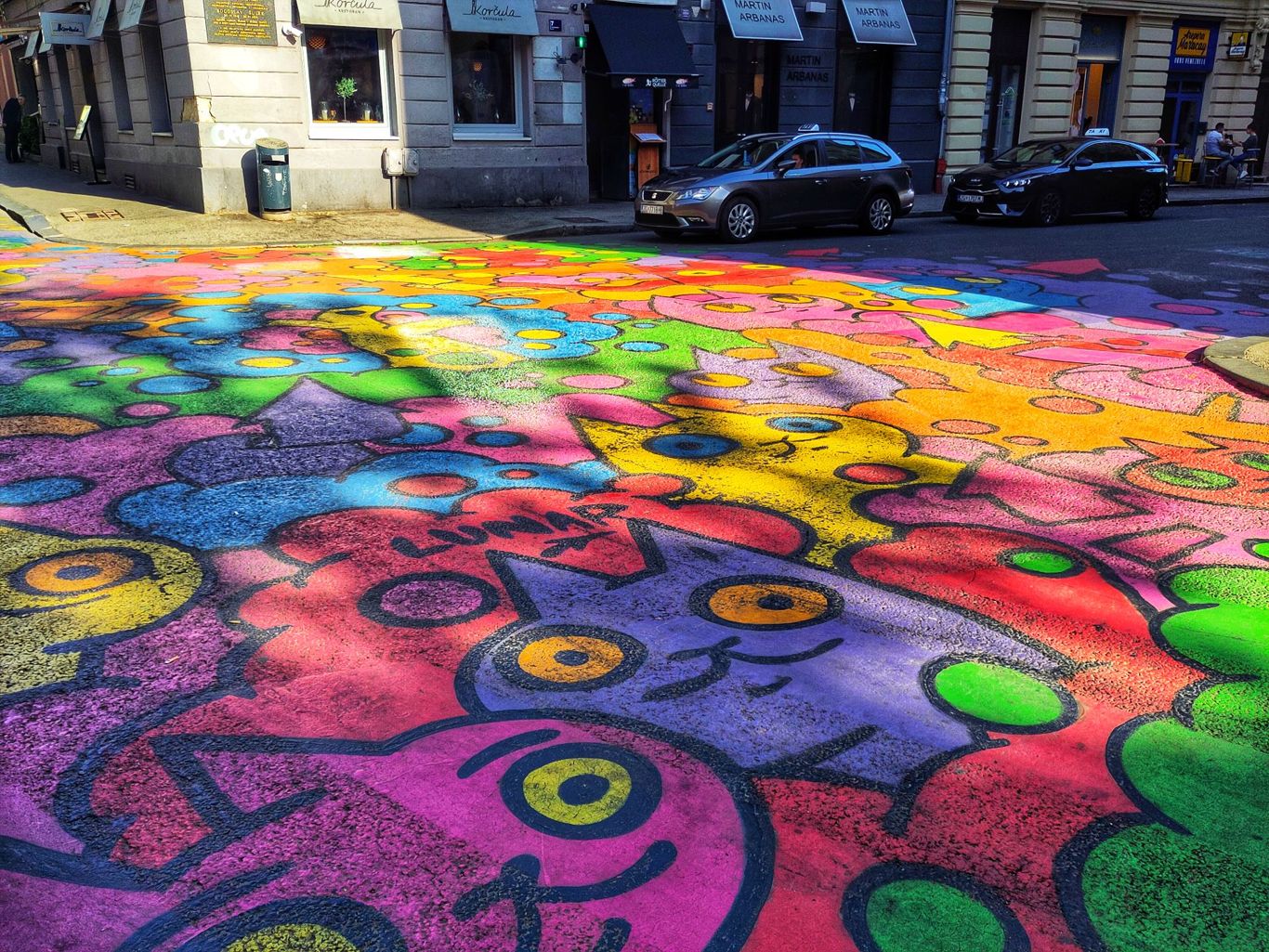
On this same street, there are many coffee shops. The rule there is to stay as long as you’d like and to bring your own food (but to get a drink there). It’s so chill, I love that vibe!
In the entire city, there are a bunch of statues. Of all these statues, there is only one woman, of course. The people whose bronze likeness is scattered all over the city are the people who embody Croatian identify and who fought for it. Alida takes the example of one writer, who was the first to write in Croatian rather than in Latin. There’s also the first published woman writer of the country, and the man who did the first speech in Croatian at the Parliament (instead of the German that was normally spoken in Austria-Hungary).
We keep following the « green horseshoe », an U-shaped street that goes from the old town to the train station and back. It’s very green, with lots of parks and trees that provide some much appreciated shade in the sweltering sun. In the middle, there are glorious buildings: the theater, the national archives, statues, a music kiosk…
Alida tells us that since Zagreb is an extremely sunny city with moderate climate, social life tends to really happen outside. That explains the green horseshoe, as well as the unlimited terraces!

I really hit it off with Alida, our guide, and stayed a while to talk with her after the tour. She recommended plenty of places to get good food before I leave.
If you ever visit Zagreb, I highly recommend you book one of this company’s bike tours, they’re fully worth it.
Before I end the day, I take the time to marvel at how everyone speaks English very well in this city. It’s really impressive! I dine at Otto&Frank, which is just as good as predicted by Alida.
I then walk home, serenaded by a surprising number of street musicians, and fall asleep before the opening of the nightclub – a tactic like any other, I suppose.
Stats
- Steps: 10 665
- Bike: 2 hours
Day 2
The problem with falling asleep early is that you also wake up early – a bit before 7am in my case.
The real mystery today is whether I’ll be able to take my train. If not, there’s a Flixbus that actually goes two hours faster, but I prefer the spirit and the experience of train travel. But here’s the situation:
- When I was in Bled, I checked the app and saw that a train reservation was mandatory. That’s fine, it was also mandatory for my first Italian train. So I clicked to book… and was told that here, the reservation was in paper format, so I needed to book a week in advance. My other option was to go to the station in Zagreb and ask for a ticket at the till. Fine.
- When I arrived in Zagreb, I got to the till (which was somehow open at 9.15pm) and the lady told me the train can’t be booked in advance and that I should « just speak to the conductor » when I board. Okay…
- Yesterday, Alida told me that if the train can’t be booked, there’s a strong chance that it doesn’t exist, no matter what the apps say. Trains are extremely unreliable in Croatia and even if this one runs I should expect delays. She advised me to get a lot of water and some food, in case the journey is more than an hour late. Nice.
So this morning, after checking out as late as possible (I’m still tired), I’m planning on going back to the train station and asking again, just in case. And if not, I’ll have my Flixbus pass ready, I guess.
A trio of police officers is smoking cigarettes in the breakfast room because why would police officers follow the law, I guess. (There was also a lot of smoking in the bar when I arrived two days ago, but in the evening it doesn’t bother me as much.) I try to focus on my cereal and not to feel sick. It goes okay, but breakfast is ruined.
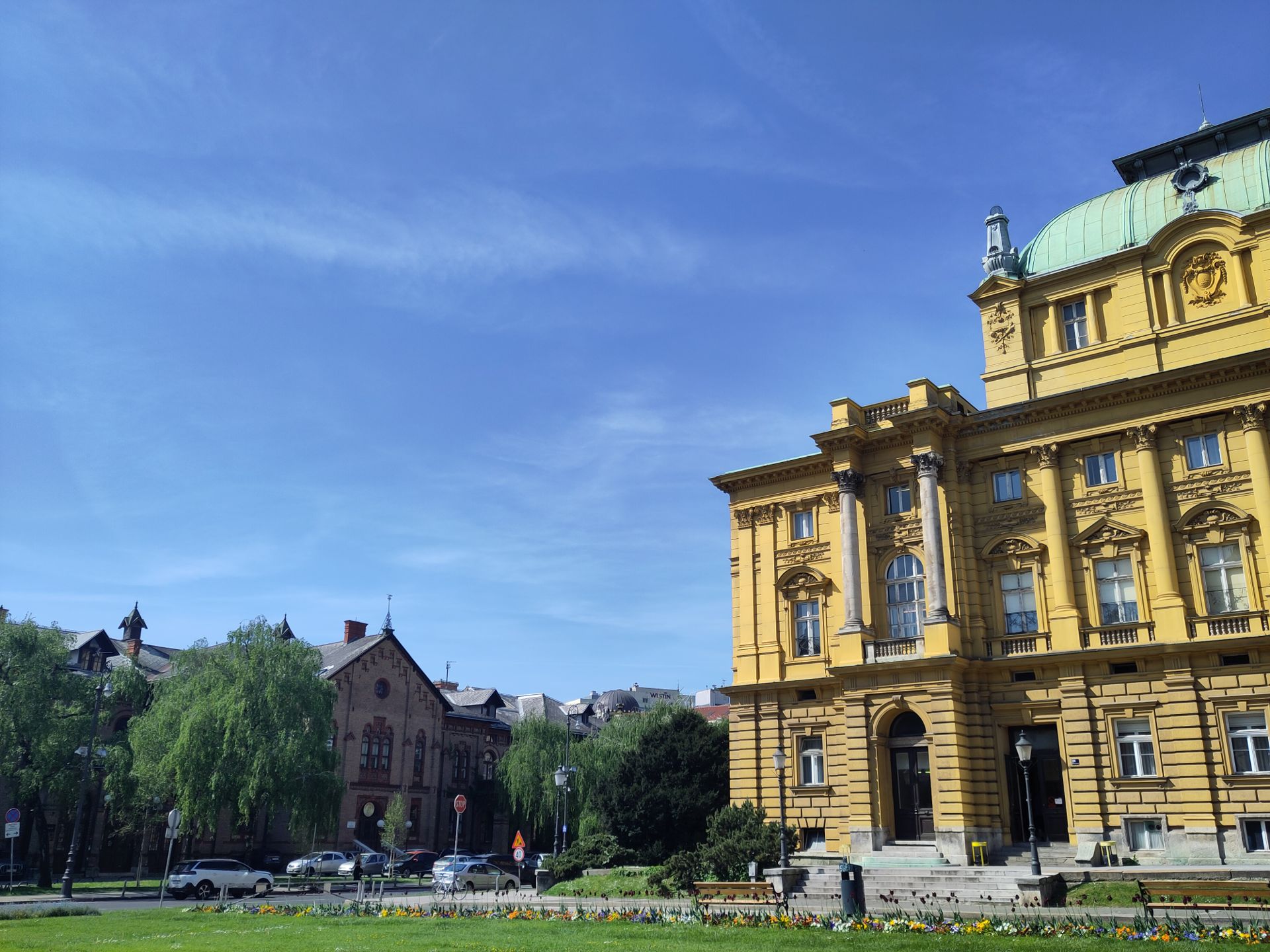
At the train station, I ask for exactly the same thing as I did two days ago, but this time the receptionist immediately prints a ticket. I am confused but satisfied.
My goal today is to visit Novi Zagreb, the part of Zagreb that’s South of the river and was built during the socialist era with very typical architecture. It has houses (cute), residential buildings (just as bad as they are at home), and official buildings (going from « ohh, chunky, I like it » to « wow this is really cool »).
But what surprised me the most is how green the area is. We definitely have housing bars like these in France, but they’re usually either all grey or there’s an anemic and yellowed park in the middle. Here, the lush trees and grass make even the most basic building much prettier.
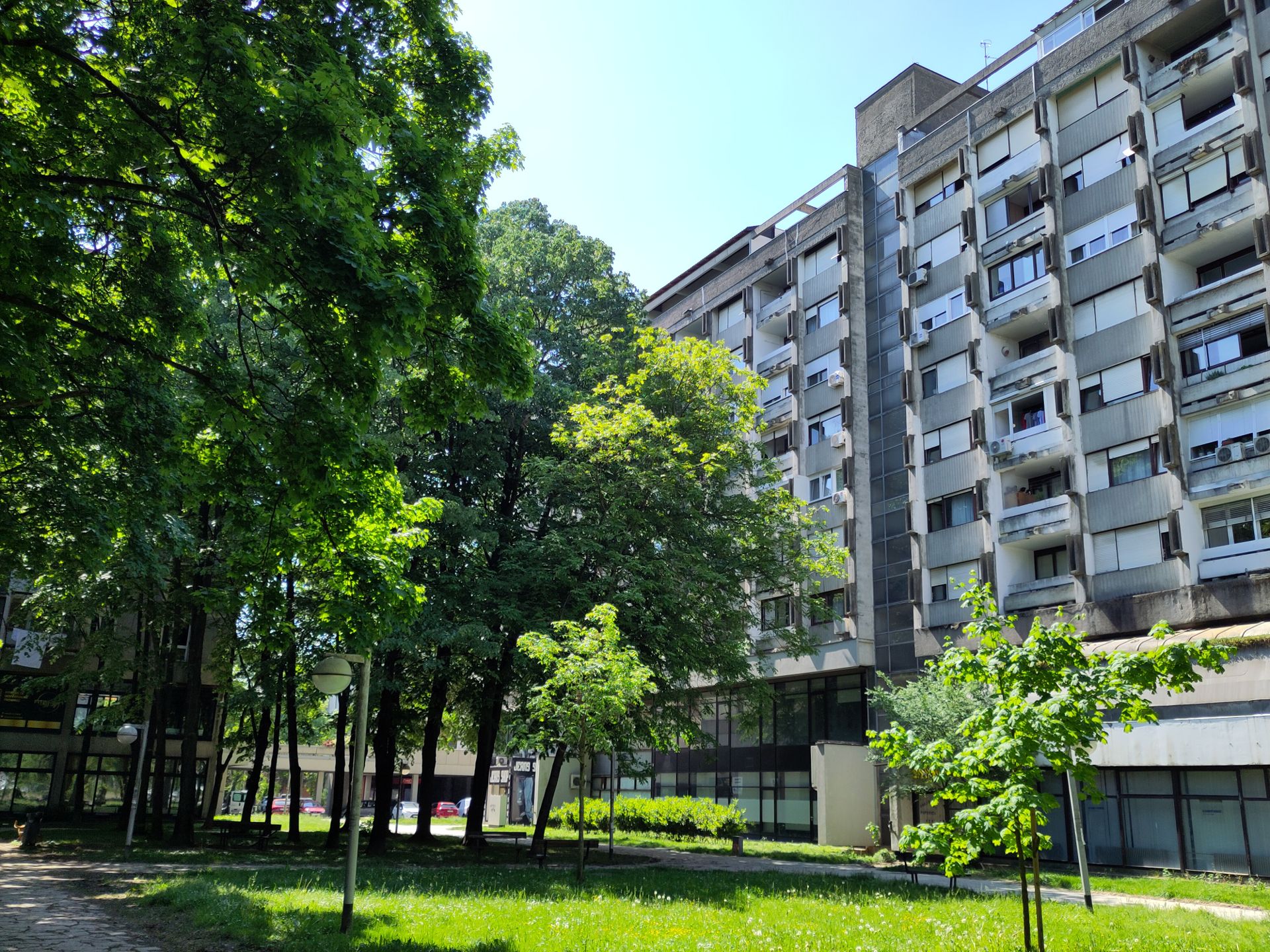
After finishing my little trip, I go to the riverside, a gorgeous and large trail where people run, talk, sit down (so many benches!!) and do all sorts of things.
In terms of decoration, it’s pretty wild. First, there’s this Heineken boat.
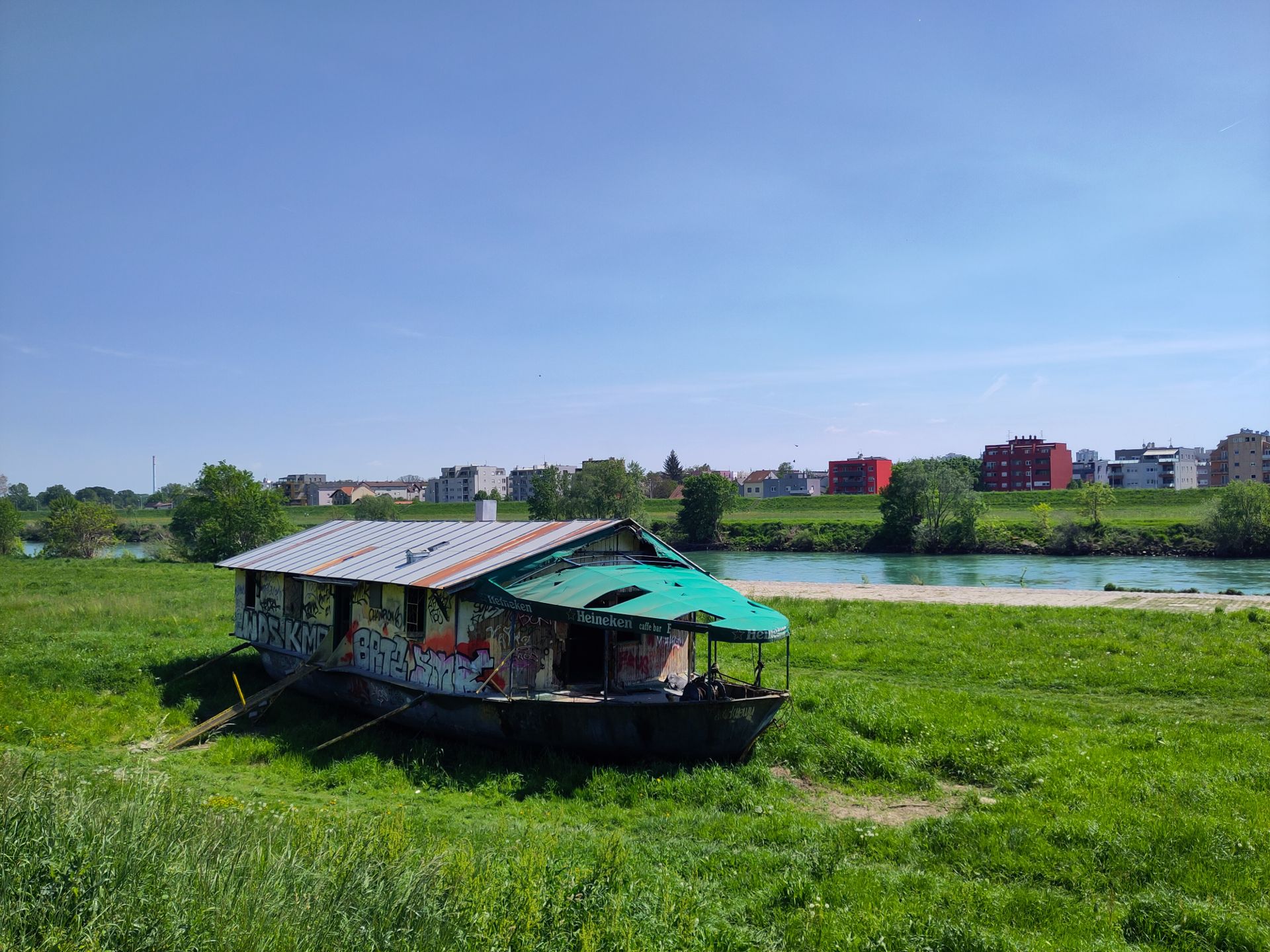
And then, as I follow the trail, I see a dozen sculptures, some very abstract, others more figurative, like this pair of legs.
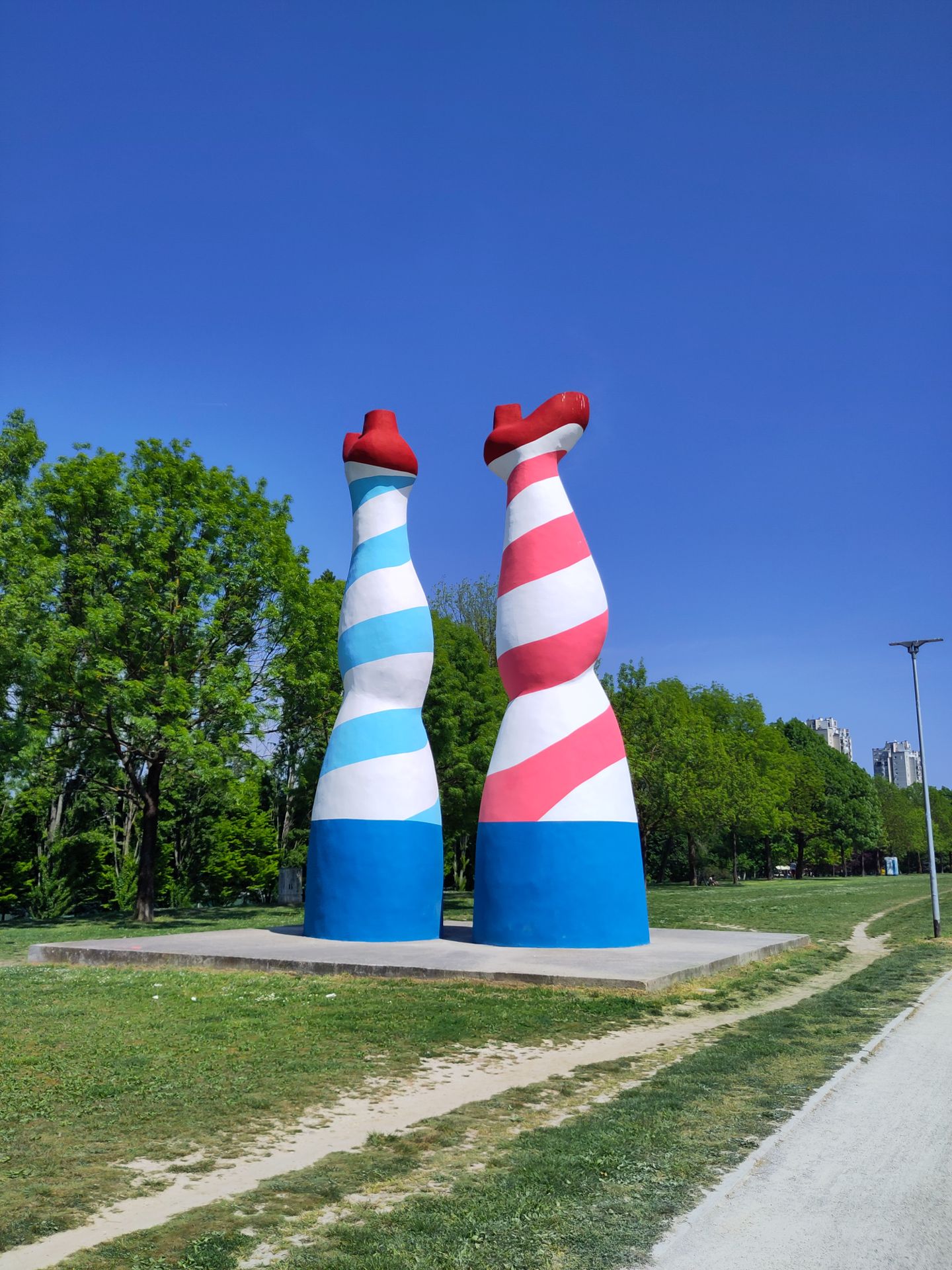
While there are many fountains in Novi Zagreb, I cycle past three or four that aren’t working, then two more that I cannot figure out how to operate. In the end, desperate and dehydrated, I ask a nice lady to help me and she shows me that I have to push with both hands, and then hold the lever very firmly, and then somehow sprout a third hand to fill my bottle, I guess. Eventually it works out and I finally get some water. It feels like heaven.

Around 2pm, I come back to the city center for lunch. I go to La Štruk, a small restaurant that has an adorable indoor garden. Whereas the struklji were already my favourite meal in Ljubljana, here they are gratiné, which adds a layer of chompiness to them. (Struklji are very confusing and I don’t think I can define them much better as « basically steamed lasagna », which they’re really not.)
If you visit Zagreb, I recommend this restaurant, although it takes a solid half hour to get served (they make the food once it’s ordered) so you need to have enough time!
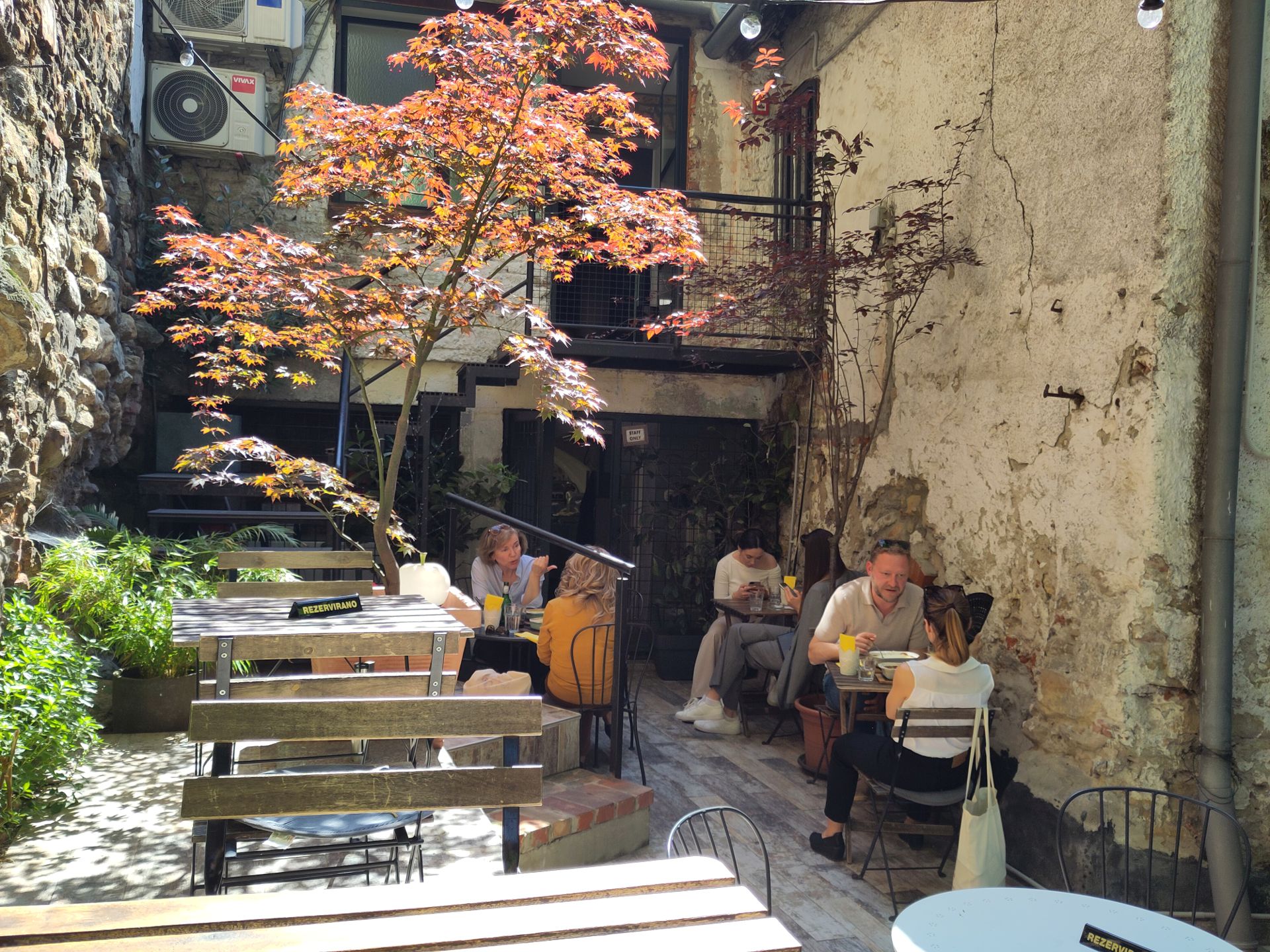
It’s already time for me to leave Croatia. I go to the train station, armed with the prized ticket I worked hard on getting, and look for quay 6, which is somehow 500 meters away from the main station because I guess otherwise it wouldn’t be fun?
I am now on the train, it’s on time (for now), and I can write relatively comfortably. I still wish I had brought a pop socket or handle or something to hold my phone upright and/or attach it to handles instead of typing blindly with the keyboard and then reviewing the glaring errors using the phone, but eh. At least I’m there, and I will be for the next six hours.
Next up: Budapest!
If you see this after your page is loaded completely, leafletJS files are missing.
- Previous stop: Slovenian lakes
- Full trip
- Next stop: Budapest, Hungary
